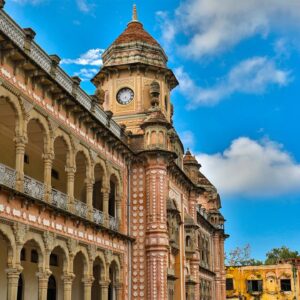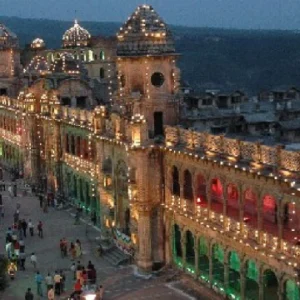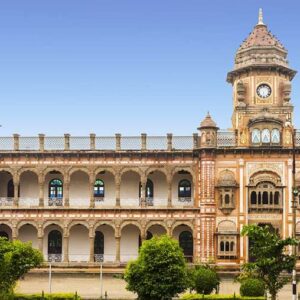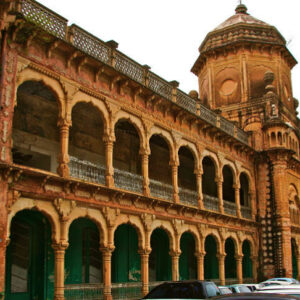Introduction
Situated in the heart of Jammu on an elevated ridge over the calm Tawi River, lies a beautiful example of royal heritage – Mubarak Mandi Palace. The palace complex is not merely a Historic Palace; it is a living artifact of Jammu’s past, royal history, cultural diversity, and architectural magnificence. Once housed the Dogra kings who ruled the princely state of Jammu and Kashmir, Mubarak Mandi, is still one of the most majestic representations of royal heritage in the area.
Beyond its façade as a tourist hotspot, the palace serves as an emotional linkage to a time during which a treasure trove of art, culture and royalty blossomed in this region. The palace’s courtyards, halls, arches, and balconies are full of intricacy and detail, showcasing the vast influences of the architectural styles of the Mughal, Rajasthani, and European heritage, making it a site of visual delight for both history and architecture enthusiasts, or simply the curious traveler.
In this complete travel guide, by Travelogear Holidays, we introduce you to the Palace of Mubarak Mandi, including its interesting history, architecture, royal significance, must see sites, travel advice, and everything else you need to facilitate your perfect visit!




A Royal Legacy – The History of Mubarak Mandi Palace
The histor of Mubarak Mandi completes the legacy of the glory of the princely House of Dogra, one of the most powerful royal families in northern India. The palace complex was initiated in the early decades of the 19th century, around 1824, during the reign of Maharaja Gulab Singh, the founder of the Dogra dynasty and the first ruler of the princely state of Jammu and Kashmir. Over the next 150 years, Dogra rulers continued to enhance and decorate the palace complex as it became the royal and administrative residence.
For years, Mubarak Mandi was at the centre of Dogra rule—the site for royal functions, official and ceremonial meetings, coronations, and state matters. The complex was also the residence of royal family members who ruled an enormous area that extended from the plains of Jammu to the high Himalayan landscapes in Ladakh and Gilgit-Baltistan.
Long after India was independent and Jammu and Kashmir merged into the Indian Union, Mubarak Mandi continued to be revered as a site of cultural and historical significance. Today, it is a testament to the grandeur of the royal past of Jammu and the cultural legacy from the Dogra period.
Architectural Marvel – A Fusion of Styles
Mubarak Mandi Palace is remarkable for its varied architectural styles. In contrast to most Indian palaces, it is a dynamic fusion of Rajasthani, Mughal, Baroque, and European antecedents. It is a beautiful amalgamization of styles conveying centuries of changing tastes, artistic inspiration, and royal pursuits.
Some of the architectural highlights include:
- Spacious Courtyards: The palace complex is built around extensive courtyards, which used to serve as places for royal gatherings, official events, and cultural shows.
- Fancy Arches and Domes: The elegant Mughal-style arches, domes, and minarets give a feeling of grandness.
- European Style: Several of the buildings have columns, decorative cornices, and large verandas inspired by Baroque and colonial styles.
- Beautiful Jharokhas: The Rajasthani-style jharokhas (overhanging balconies) provide a regal feature and stunning views of the surrounding area.
- Baked Bricks and Stone: The palace is built of baked bricks and red sandstone, evoking charm and longevity.
Notable Sections of Mubarak Mandi Palace
The expansive palace complex takes up more than 43 acres and is comprised of a myriad of buildings, courtyards, halls, and pavilions. Each space is imbued with its special charm and history, history and architectural significance. Here are a few of the notable features of the complex that you will want to pay a visit to:
1. The Pink Hall (Dogra Art Museum)
The Pink Hall, one of the complex’s most beautiful buildings, now features the Dogra Art Museum, which includes items that highlight the region’s cultural and artistic heritage, including rare manuscripts, miniature paintings, royal costumes, antique coins, and antique weapons. The pièce de résistance of the collection is a 600-year-old manuscript of the Shahnama, a classic Persian epic.
2. Darbar Hall
The Darbar Hall was the epicenter for royal power – the venue for coronations, state functions, and perhaps the most important political meetings. Its chandeliers, frescoed ceiling, and extensive woodwork are a testament to the Dogra court’s princely majesty.
3. Gol Ghar
This circular building, known as the Gol Ghar, was utilized as a council chamber and meeting hall. Its unique architecture, alongside its bird-eye level views, has made it one of the most photographed parts of the palace.
4. Rani Charak Mahal
A section dedicated to the queens and royal women, Rani Charak Mahal showcases exquisite
Cultural Significance of Mubarak Mandi Palace
Aside from being a great architectural feat, Mubarak Mandi is a cultural and historical landmark full of value. It is a representation of Dogra identity, a record of the region’s royal history, and a living museum of Jammu in its course of evolution over the last several centuries.
- Significance in terms of the political role it was the administrative seat of Dogra kingdom and the center of political power.
- Significance of Cultural Role: The palace was the venue for music, literature, and religious proceedings, and it is the basis for a rich culture.
- Symbol of Unity: The palace was the capital of a diverse kingdom that practiced unity among peoples of diverse ethnic and religious groups.
Best Time to Visit Mubarak Mandi Palace
The palace can be visited at any time of the year, but the experience is dramatically more enjoyable during pleasant weather.
- October to March: The best time to experience the palace. The cool, pleasant weather allows visitors to roam the palace and gardens comfortably.
- April to June: Warm but tolerable. Early mornings and late afternoons are suitable visits in the heat of the day.
- July to September: The rainy season means everything is lush and green, but there’s also a chance of showers.
Pro Tip: Consider visiting early in the morning or late in the afternoon to take advantage of the soft natural light which highlights the beauty of the palace in photographs.
Entry Fees & Timings
Timings: 10:00 AM – 5:00 PM (Closed on Mondays and public holidays)
Entry Fee:
Indian Nationals: ₹20 – ₹50
Foreign Nationals: ₹100 – ₹200
Additional fees may apply for museum entry and photography.
How to Reach Mubarak Mandi Palace
Mubarak Mandi Palace is located in the center of Jammu, making it easily reachable by air, train, and road.
By Air: The closest airport to the palace is Jammu Airport (Satwari Airport), located only about 8 km from the palace.
By Train: The railway station is Jammu Tawi Railway Station, which is only about 5 km away from the palace.
By Road: The palace is well-connected by road, and can be reached by taxi, a local bus, or auto-rickshaw from anywhere in town.
Things to Do at Mubarak Mandi Palace
Going to the Mubarak Mandi Palace is more than a just simple sightseeing trip — it is an immersive journey into history and culture. Find out how to maximize your visit:
1.Explore the Palace Complex: Stroll through its courtyards, halls, and passageways to obtain a flavor of the lavishness of the Dogra period.
2. Stop at the Dogra Art Museum: Peruse artwork, manuscripts and other historical period objects that tell the royal story of Jammu over the years.
3. Attend a Cultural Event: On occasion cultural programs and exhibitions take place in the palace period — it an terrific way to connect with and participate in local traditions.
4. Photograph the Palace: Snap photographs of the architectural elegance, intricate detail and beautiful surrounding structures or scenery of the Palace.
5. Enjoy Views of the Tawi River Valley: There are great spots throughout the palace area where you can get great views of the Tawi River and the surrounding Jammu countryside or landscape.
Nearby Attractions
Make your outing more fulfilling by visiting some additional attractions in Jammu.
Bahu Fort & Bagh-e-Bahu Garden: A historic fort and tranquil garden overlooking the Tawi River.
Raghunath Temple: One of the biggest temple complexes in northern India.
Ranbireshwar Temple: Notable for the enormous Shivalingas.
Amar Mahal Palace: A palace in European style now a museum displaying royals.
Peer Kho Cave Temple: A holy place of worship dedicated to Lord Shiva.
Travel Tips for Visitors
- Put on comfortable shoes, since there will be a lot of walking.
- Bring water with you, especially in the summer.
- Consider hiring a local guide for more information on the history of the palace.
- You can take photographs, but may have to pay extra in certain areas.
- Try to visit on a weekday to avoid the bulk of the crowds.
Why Explore with Travelogear Holidays
The experience of discovering a historical treasure like Mubarak Mandi Palace can be further enhanced with the right travel companion. Travelogear Holidays offers guided tours that focus on heritage, with a strong emphasis on history, as well as comfortable transport, tailored itineraries, and live local experiences. Regardless of being a history buff, photographer, or culturally-keen adventurer, our unique journeys will amply and affordably provide for you as you explore the royal heart of Jammu.
Conclusion
Mubarak Mandi Palace is not simply a building: it is a living history of Jammu’s royal heritage, cultural journey, and architectural beauty. Every wall, courtyard, and gallery in the palace has revealed stories of kingship, artistic expression, faith, and history. The palace, ranging from royal museums and grand hallways to stunning river views and architectural beauty, is one of the most inspiring places in Jammu for discovering the essence of the city.
So if you’re heading to Jammu, be sure to include Mubarak Mandi Palace as a place to visit. And with Travelogear Holidays planning and traveling with you, you’ll visit this beautiful landmark in the most exploratory and unforgettable way it should be discovered.
Top 10 FAQs About Mubarak Mandi Palace
1. Who built Mubarak Mandi Palace?
The palace was built by the Dogra kings, starting with Maharaja Gulab Singh in the early 19th century.
2. What is Mubarak Mandi Palace famous for?
It is known for its stunning architecture, historical significance, and its role as the royal seat of the Dogra dynasty.
3. Where is Mubarak Mandi Palace located?
It is situated in the heart of Jammu city, overlooking the Tawi River.
4. What is the best time to visit the palace?
The best time is between October and March, when the weather is cool and pleasant.
5. Is there an entry fee for the palace?
Yes, a nominal entry fee is charged, and additional fees may apply for the museum and photography.
6. Can we visit the Dogra Art Museum inside the palace?
Yes, the Pink Hall houses the Dogra Art Museum, which showcases artifacts, paintings, and manuscripts.
7. How much time is required to explore the palace?
Approximately 2 to 3 hours are sufficient to explore the palace and museum comfortably.
8. Is photography allowed inside the palace?
Yes, photography is permitted in most areas, though certain sections may require an additional fee.
9. Are guided tours available?
Yes, guided tours are available and recommended for a deeper understanding of the site’s history.
10. What are the nearby attractions to visit along with the palace?
Bahu Fort, Amar Mahal Palace, Raghunath Temple, and Bagh-e-Bahu Garden are popular nearby attractions.
How to book Mubarak Mandi Palace Tour Packages With Travelogear Holidays?
For a seamless and exceptional booking experience,
Contact Travelogear Holidays at: reservationtravelogearholidays@gmail.com or call us at : 9906903196

